Chapter: 12th Nursing : Chapter 1 : Human Anatomy and Physiology
Nervous System
Nervous System
The nervous system is the most complex of all the systems which
coordinates controls and enables all body functions like movement, thinking,
autonomic, or automatic, reflexes and sensory perception. The nervous system
sends messages to all parts of the body and receives it. For example, when a
person touches fire, the message is sent to the brain which interprets and
sends a message to the person’s finger to suddenly remove it.
The Parts of the Nervous System
·
The central nervous system
·
The peripheral nervous system
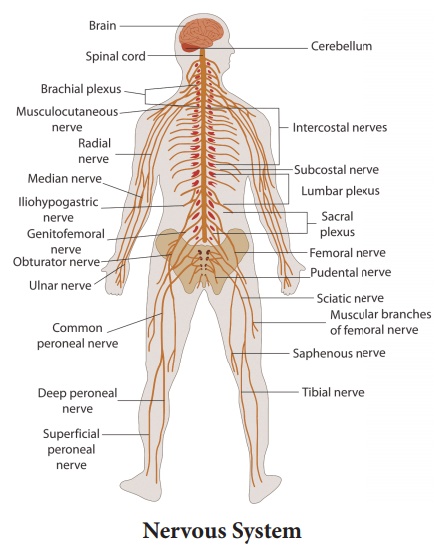
The parts of the central nervous system are the
·
Brain
·
Spinal cord
The Brain
The brain is placed inside a skull or cranium which protects it.
The brain consists of three major parts, two hemispheres (right and left
hemisphere) and meninges, the protective membrane.
The meninges have three layers (PAD)
P-Pia mater (inner)
A-Arachnoid (middle)
D-Dura mater (outer).
The spinal cord is covered with meninges. The subarachnoid space
(space between the arachnoid layer and the pia mater) contains the
cerebrospinal fluid.
Cerebrospinal fluid (CSF)
CSF fluid is a clear, colorless body fluid found in the brain and
spinal cord. It is about 125ml of CSF at any one time and about 500ml is
generated everyday.
CSF acts as a cushion or buffer for the brain, providing basic mechanical and immunological protection to the brain inside the skull.
The brain is also divided into three major areas
·
Cerebrum
·
Cerebellum
·
Brain stem
Cerebrum
The cerebrum is the largest part of the brain and its lobes
coordinate and enable body movement, sensory perception, learning, olfactory
sense, gustatory sense, optic sense, auditory sense, memory, thinking, judgment
and communication abilities.
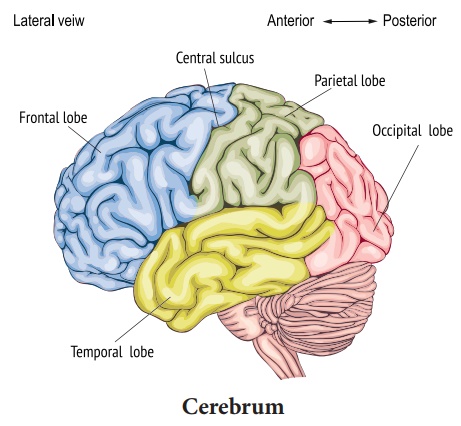
The cerebrum has four major lobes which, as shown in the picture
above, are:
·
The frontal lobe
·
The temporal lobe
·
The parietal lobe
·
The occipital lobe
The frontal lobe is responsible for thinking, movement, judging
and writing.
The temporal lobe plays a role in terms of memory and hearing.
The parietal lobe helps in sensory perception.
The occipital lobe facilitates understanding written language and
vision.
Cerebellum
The cerebellum, referred as the little brain or hind brain is much
smaller than the cerebrum and lies behind the other parts of the brain. The
cerebellum controls motor nerves, balance, equilibrium, fine motor coordination
and gross motor coordination.

Brain stem
The brain stem lies at the base of the skull and between the right
and left hemispheres of the brain.
The brain stem has three sections
·
Midbrain
·
Pons
·
Medulla oblongata
The midbrain controls messages sent from other higher areas of the
brain to the pons and medulla below it and it also controls posture.
The pons connects the midbrain and the medulla. The pons controls
the rhythm of respirations.
The medulla oblongata connects the pons and the spinal cord
through a hole in the base of the skull called the foramen magnum. The
medulla is the center of control for breathing and cardiac functioning and
manages swallowing, vomiting, cough, and sneeze reflexes.
The Spinal Cord
The spinal cord connects the brain to the peripheral nervous
system throughout the body. The spinal cord is protected with the meninges and
the spinal column.
The spinal cord is divided into different parts, which are:
·
Cervical region
·
Thoracic region
·
Lumbar region
·
Sacral region
·
Coccyx, or tail bone, region
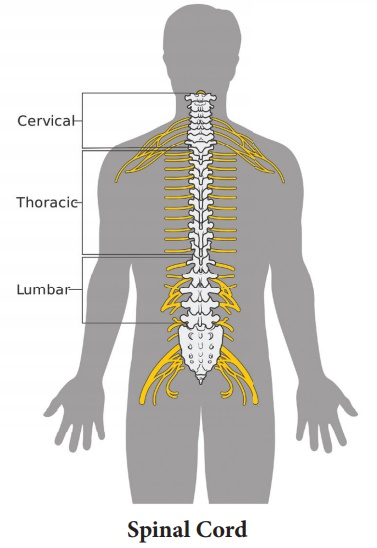
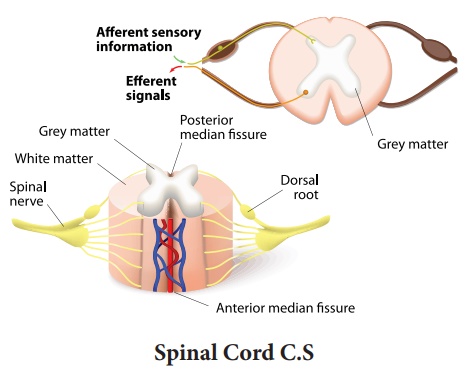
The spinal cord has 31 nerve clusters which sends and receives
motor and sensory messages to and from the rest of the body and it coordinates
reflex action.
The Peripheral Nervous System
The Parts of the Peripheral Nervous System
Peripheral nervous system consists of all the parts of the nervous
system other than the brain and the spinal cord. The peripheral nervous system
is not protected with bones.
The peripheral nervous system is divided into two:
·
Autonomic nervous system
·
Somatic nervous system
Autonomic nervous system
The autonomic nervous system controls automatic and involuntary
physiological functions of the body that are out of our control like the
movements of smooth, involuntary muscles. For example, the constriction of the
eye’s pupil when it is exposed to bright light.
The autonomic nervous system’s functions can be further divided
into:
Sympathetic nervous system
Sympathetic nervous system is responsible for the fight and flight
syndrome that results from stress. These responses include an increased heart
rate, pupil dilation and decreased peristalsis.
Parasympathetic nervous system
The parasympathetic nervous system manages the functions related
to rest. For example, the parasympathetic nervous system manages involuntary
control of tears, digestion and the production of saliva.
Somatic nervous system
The somatic nervous system controls voluntary muscular movement with
the skeletal muscles of the body. The somatic nervous system has efferent and
afferent nerves which send and receive motor function related nerve signals.
Reflexes
A reflex is a muscle reaction that automatically occurs in
response to a stimulus.
There are two types of reflexes.
Infant reflexes
Reflexes present at the time of birth, but disappear shortly
thereafter.
Other reflexes
Reflexes present at the time of birth and remain active throughout
life time. For example, the pupil reflex, sneeze reflex, blinking reflex, cough
reflex and yawn reflex.
Twelve Cranial Nerves
Remember the mnemonic: One Old Owl Turned
Top, A Fat Aunt Go Viewed Some Hop
·
Olfactory: smell
·
Optic: vision
·
Oculomotor: eye movements.
·
Trochlear: eye movements.
·
Trigeminal: chewing and sensory to face
·
Abducens: eye abduction.
·
Facial: facial expressions, the tongue and the salivary glands.
·
Acoustic/Auditory: hearing
·
Glossopharyngeal: taste impulses and the secretion of
saliva from the parotid gland.
·
Vagus: respiratory and the digestive systems such as the pharynx
and swallowing.
·
Spinal accessory: movement of shoulder.
·
Hypoglossal: Tongue movement.
Functional Units of Nervous System
The nervous system is comprised of millions of neurons and glial
cells.
Types of nerves
Sensory or afferent nerves
Motor or efferent nerves
Mixed nerves
Neuron
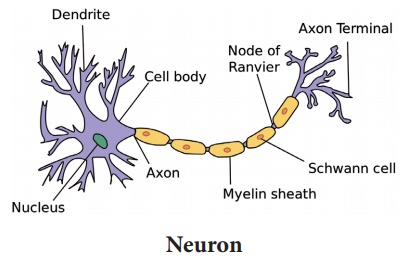
The neuron is the primary type of nerve cell in the nervous
system. Glial cells forms myelin sheath over the neuron for protection.
Neurons communicate with other neurons by sending impulses at the
synapse, a point of junction between any two neurons. There are two types of
neurons which are sensory neurons and motor neurons. Sensory neurons sense and
transmit information such as taste, touch and sight. Motor neurons send and
transmit messages that involve muscle movement.
Glial Cells
Glial cells are non-neuronal cell that provide support and
nutrition, maintain homeostasis, form myelin and patricipate in signal
transmission in the nervous system.
Types of nerves
Sensory or afferent nervesWhen action potentials
are generated by sensory receptors on the dendrites of these neurons, they are
transmitted to the spinal cord by the sensory nerve fibres. The impulses may
then pass to the brain or to connector neurons of reflex arcs in the spinal
cord motor or efferent nerves.
Motor nerves originate in the brain, spinal cord and autonomic ganglia.
They transmit impulses to the effectors organs muscles and gland. There are two
types:
Somatic Nerves – involved in voluntary and reflex
skeletal muscle contraction.
Autonomic Nerves (sympathetic and parasympathetic) –
involved in cardiac and smooth muscle contraction and glandular secretion.
Mixed Nerves: In the spinal cord, sensory and motor nerves are arranged
in separate groups or tracks. Outside the spinal cord, when sensory and motor
nerves are enclosed with the same sheath of connective tissue they are called
mixed nerves.
Disease related to nervous system
·
Seizures
·
Stroke
·
Epilepsy
·
Meningitis
·
Paralysis
·
Multiple sclerosis
·
Parkinson’s diseases
·
Alzheimer’s disease
·
Bell’s palsy.
Related Topics